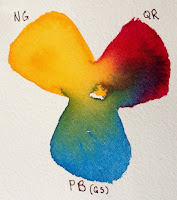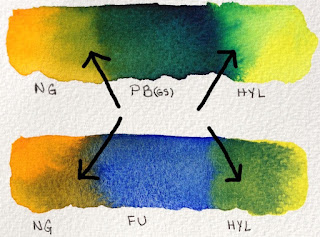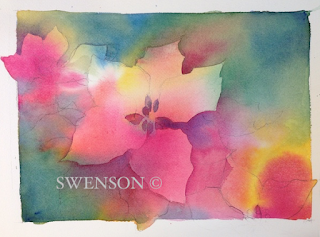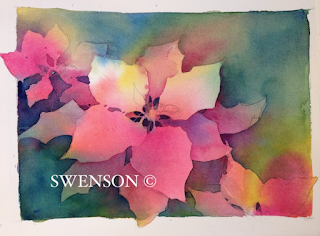One color that gets a lot of people in trouble is green. Tube green to be exact. Any tube of green by itself isn’t believable. Every tree, shrub or flowering plant is going to shift in greens from warm to cool, pure to grayed…and so on. A landscape is going to shift in greens too. Warmer yellow-greens in the foreground and cooler blue-greens as you go back.
How do you make believable greens? One word…PRACTICE. It’s not that hard. I recommend you start by keeping a book for color mixing only. I call these my color bibles. I’ve built many reference books over the years. Combinations I refer to again and again. Greens, triads…and so on.
Mixing paint on the paper (not on the palette) will give you the most interesting greens. Why? You’ll have more variations. I’m sharing greens I made using the current colors on my palette. All of the colors listed below are Daniel Smith Watercolors with the exception of Burnt Sienna which is Winsor Newton. I’ve label all the paint swatches with abbreviations. If you're not familiar with color index code, don't worry. The first letter P means pigment, the next letter is pigment color family (R=red, B=blue…and so on) and the final number is the number issued by the ASTM (American Society for Testing Materials).
 |
| Mixing paint on dry paper |
Abbreviation (HYM), Paint Name (Hansa Yellow Medium), Color Index Code (PY97)
HYM=Hansa Yellow Medium, PY97
RSL=Raw Sienna Light, PY42
PYD=Permanent Yellow Deep, PY110
GG=Green Gold, PY 150, PY 3, PG 36
QG=Quinacridone Gold, PO 48 PY, 150
MBH=Manganese Blue Hue PB15
FU=French Ultramarine, PB29
PT=Phthalo Turquoise, PB15:3, PG36
BS=Burnt Sienna, PR101
LB=Lunar Black, PBk11
 |
| Last week images were taken from my blog without permission. Watermarks © have become an unpleasant necessity. |
How many green combinations can you identify in my sketch? Some greens are very yellow and other are more blue, grayed...
Hint: If a green area goes dull add a touch of Quinacridone Rose or Magenta when the pigment is still damp to liven it up.
Happy Painting!
Brenda
































